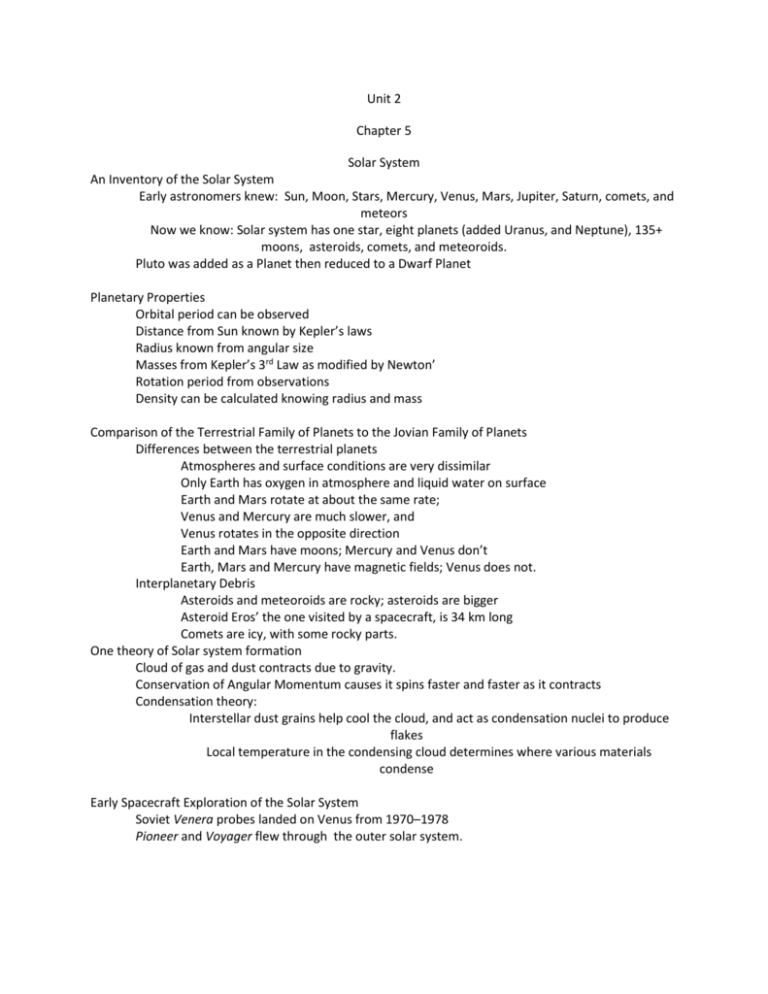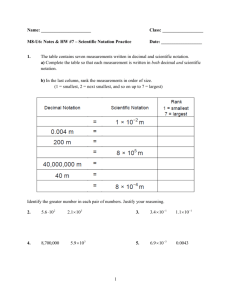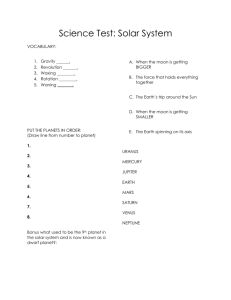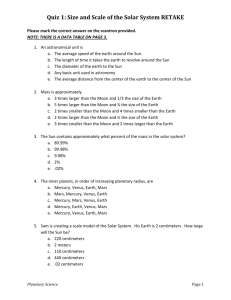Unit 2 Chapter 5 Solar System An Inventory of the Solar System
advertisement

Unit 2 Chapter 5 Solar System An Inventory of the Solar System Early astronomers knew: Sun, Moon, Stars, Mercury, Venus, Mars, Jupiter, Saturn, comets, and meteors Now we know: Solar system has one star, eight planets (added Uranus, and Neptune), 135+ moons, asteroids, comets, and meteoroids. Pluto was added as a Planet then reduced to a Dwarf Planet Planetary Properties Orbital period can be observed Distance from Sun known by Kepler’s laws Radius known from angular size Masses from Kepler’s 3rd Law as modified by Newton’ Rotation period from observations Density can be calculated knowing radius and mass Comparison of the Terrestrial Family of Planets to the Jovian Family of Planets Differences between the terrestrial planets Atmospheres and surface conditions are very dissimilar Only Earth has oxygen in atmosphere and liquid water on surface Earth and Mars rotate at about the same rate; Venus and Mercury are much slower, and Venus rotates in the opposite direction Earth and Mars have moons; Mercury and Venus don’t Earth, Mars and Mercury have magnetic fields; Venus does not. Interplanetary Debris Asteroids and meteoroids are rocky; asteroids are bigger Asteroid Eros’ the one visited by a spacecraft, is 34 km long Comets are icy, with some rocky parts. One theory of Solar system formation Cloud of gas and dust contracts due to gravity. Conservation of Angular Momentum causes it spins faster and faster as it contracts Condensation theory: Interstellar dust grains help cool the cloud, and act as condensation nuclei to produce flakes Local temperature in the condensing cloud determines where various materials condense Early Spacecraft Exploration of the Solar System Soviet Venera probes landed on Venus from 1970–1978 Pioneer and Voyager flew through the outer solar system. Chapter 6 Earth The interior of the Earth has been determined by studying the transmittal and reflection of Seismic Waves within the Earth. Seismic waves are sound waves generated by earthquakes. They are compression waves and sinesoidal waves. They reflect from and transmit through layer interfaces with the Earth. The Earth has a solid iron inner core, a liquid iron outer core, a liquid rocky mantle and a solid rocky crust Can use the pattern of reflections made during earthquakes to deduce interior structure of Earth Crust The crust of the Earth is divided into several plates that move with respect to each other. The movement is driven by convection currents in the mantle. Plate movement results in earthquakes and volcanism Interactions between the plates are: transform, sliding against each other; divergence, separating; convergence, coming together. When plates slide against each other cracks (faults) occur and earthquakes happen. The twisting Pacific plate has produced many earthquake zones and many active volcanoes. At divergent boundaries new crust is made. At convergent boundaries crust is lost by subduction (sliding under) and crumpling (mountain building) The Earth’s magnetic field appears to be generated by electric currents circulating the liquid iron core. The trapped hot charged particles in the Van Allan belts are shunted toward the magnetic poles where they interact with the air molecules. The particles are cooled by the air which glows as auroras. The Earth’s Biosphere, Oceans and Atmosphere, come from hydrogen rich gasses trapped inside the Earth during creation. By far the most abundant of the trapped gasses are methane, ammonia, and water. The Earth is the only planet where conditions are right for liquid water to exist on the surface. Trapped gasses Outgassing Water Nitrogen Carbon Dioxide Plant Life Oxygen The Earth’s Atmosphere Troposphere is where convection takes place – responsible for weather The blue curve shows the temperature at each altitude Convection depends on warming of ground by the Sun Ionosphere is ionized by solar radiation, and is good conductor Reflects radio waves in the AM range, but is transparent to FM and TV Ozone layer is between ionosphere and mesosphere; absorbs ultraviolet radiation The Human Element More Humans, Industrial Revo-lution Global Warming (?) Chapter 7 The Moon The seismograph placed on the Moon by the Astronauts of the Apollo Program Does the moon rotate? What if the Moon did not rotate? Synchronous Rotation One rotation for one revolution Lunar Phases as described by Aristotle We only see the lighted portion of the Moon Craters on the Moon and the Earth Impact Maria, Basins, Rays Impact and volcanism Rills and Domes Volcanism Craters, Maria and Basins are all due to meteorite impact Moon has large dark flat areas, due to impact and lava flow, called maria or basins (early observers thought they were oceans or seas) Far side of Moon has some large craters, but no large maria. The reason for this difference is still not fully understood. Meteoroid strikes Moon, ejecting material; explosion ejects more material; leaving crater, lips (rim) and ejecta Regolith: The surface of the moon is heavily cratered. One of the results of the infalling bodies is to pulverize the surface, thus creating a layer debris, much of it is very fine dust. The surfaced is layered with debris on top of pulverized rock. Most lunar craters date to at least 3.9 billion years ago; much less bombardment since then. Craters are typically about 10 times as wide as the meteoroid creating them, and twice as deep as they are wide. Early Intense Bombardment Moon is still being bombarded by very small objects called “micrometeorites” which trends to round the edges of craters and leave a layer of dust. Meteorites also hit Earth; i.e. Meteor Crater in Arizona The great “lakes “ of liquid rock that filled the large craters are greatest evidence of vulcanism on the moon. Vulcanism ceased when the moon cooled. This is an edge of a mare. The sooth appearance is due to the lava that flowed up through cracks , smoothed out then cooled. Hadley Rill seems to be an extended lava tube whose roof has fallen in. There are other caved in lava tubes but they are much shorter Moon’s density is relatively low, and it has no magnetic field – cannot have sizeable iron/nickel core. Due to cooling over time the crust has thickened. Air molecules have high speeds due to thermal motion. If the average molecular speed is well below the escape velocity, few molecules will escape. Escape becomes more probable: • for lighter molecules (higher speed for same kinetic energy) • at higher temperatures • for smaller planets (escape speed is less) Early theories of the origin of the Moon The currant, post Apollo, theory is the Collision Ejection Theory. Two large planetismals collide. Their crusts splash, their interiors merge. The merged interiors become the Earth. The splashed crustal material becomes the Moon This theory accounts for the difference in density of the Moon and Earth, the reason for the high percentage of iron in the Earth, and the strange orbital placement. . Chapter 8 The Planet Mercury Elongation of Mercury The eccentricity of Mercury’s orbit allows to see it father from the sun sometimes. Mercury as Seen from Earth Synchronous rotation 1:1 Our moon All the large moons Mercury’s rotation 3:2 3 rotations to 2 revolutions Comparison of Earth’s interior to that of Mercury Mercury’s Magnetosphere Mariner 10 Trajectory Composite of the Mariner views of Mercury Craters and Planes (?) Scarp (Cliff) Edge of Caloris Basin The spacecraft MESSENGER in orbit around Mercury. Notice the shade designed to protect the MESSENGER from the brilliant sunshine. From its polar orbit MESSENGER is able to see the entire surface Messenger may have found extinct volcanos Some unusual features to be studied Some features become more evident at different lighting Some very strange terrain Mercury & Dr. Einstein Curvature of light around a large mass Orbital Precession Chapter 9 Beautiful Venus Atmosphere on Venus and on Earth Gasses from a Volcano on Earth Evidence of Eruption on Venus Greenhouse Effect Greenhouse Effect on Venus Venera Mission Venera Lander Visible images from Venus by Venera Magellan Spacecrafrt Map of Venus by Magellan spacecraft More of Venus’s Sphere by Magellan Computer reconstruction o One Face of Venus o A volcanic crater o Craters and lava flow o A large volcano o A lava field and an impact crater o These are unusual ‘pancake’ lava flows o Lava fields around several craters o Lava field Chapter 10 The Planet Mars Early observers did not have photography and had to draw what they saw. In the years from about 1890 to about 1910 Percival Lowell became enamored with the observations of Schiapereli. Canali for him were canals. He believed in canals and the intelligent life forms needed to dig them. He spent many years talking and writing about them. Mars’ Properties Dist from Sun=1.5+ or app. 1.6 AU (T-B) Year = 1.88 Earth years Sol (Mars day) = 24h 37 m Axis inclination = 25+ deg Dia = .533 Earth dia Surface gravity = .38 Earth Surface Temp = -140 deg C to 20 deg C Comparison of the Atmospheres of the Terrestrial Planets Earth Venus N2 0.79 2 O2 0.20 < 0.001 Ar 0.01 0.005 CO2 0.0003 64 H2O ~ 0.02 ~ 0.01 Total 1.00 90 Mars 3 x 10-4 0-7 2 x 10-4 0.009 ~10-6 0.01 The interior of Mars has not been studied by seismic waves. Surface clues indicate that the interior as shown is likely correct. Over time the interior has cooled and vulcanism has ceased. The surface of Mars has been imaged and mapped at least as thoroughly as the Earth. No liquid water has been found although there is much evidence that there has been standing and flowing water in the past. The Southern Hemisphere is somewhat higher in elevation and covered with craters appearing much like The Moon. The lower Northern Hemisphere is much more earthlike. It has giant volcanoes and canyons. A topographical map of the Tharsis Rise shows giant volcanoes, a giant canyon, apparent dry river beds and a dry ocean If Mount Olympus a giant volcano, were on Earth is would stand three times higher than Mount Everest and would completely cover the State of Utah An image of a dry watershed An image of a dry river bed A topographic map of the mouth of a dry river entering a dry ocean A canyon land region called South Candor A panoramic view of a rocky rolling valley The North Polar Cap seems to have water ice with much dry ice covering it. There is much information in the apparent layers that have accumulated over eons. Today Cold Dry Anciently Warm Wet Robots to Mars From the Mariner Probes in the early ‘60s to the extremely successful Curiosity Lander this year, mankind has sent a variety of robot orbiters and landers to prepare the way for a future manned mission to the exotic Red Planet. Viking Program o Two Identical Systems o Orbiter o Lander o Mid 70’s o Search for Living Life o Chemical not biological results o Red color is iron oxide o A view from the Viking 2 Lander in summer and winter. The occasional frost layer only lasts until Sun up. The Mars Global Surveyor took images in visible and infrared of the entire planet every day for one full Mars year. Among its discoveries was this of recent gullies One of the trickiest parts of the Mars Exploration is actually getting the rovers to Mars in working condition.Imagine trying to drop a sophisticated robot about 11-12 stories without breaking it (or even dropping an ordinary DVD player) When the Pathfinder lander and the Sojourner rover arrived in 1997 they began the era of faster, cheaper spacecraft. Sojourner can be seen examining the rock “Yogi” The next generation Rovers were two, called the Spirit and Opportunity. o Spirit’s landing place was similar to the Vikings’; this is a 360° panoramic view o Spirit View west from the Columbia Hills o This is a view from Opportunity down into Victoria Crater. It spent nearly a full Earth year finding the best way down into the crater and this is it. o Opportunity has now left Victoria Crater in search of another crater to explore. Here we see the robotic arm at work. It cleans the rock, examines it then analyses it for elements. o This is the Instrument complex with the RAT, imager and spectrograph Discoveries – Layering as if by water deposit – Spherical pebbles such as in a stream – Rust (color) same as the red iron oxide as in Southern Utah Adventures – Stuck in sand dune – Covered by dust in a storm – Uncovered by a whirl wind – Lived through a long Mars winter Are still going strong (four times as long as expected The Pheonix scooped up icy dirt that gave off liquid water when warmed. Each Rover has become more become bigger and more complex as we have learned how to build them and use them Mars Pathfinder (Success) Mars Global Surveyor (Success) Actively taking pictures and gathering data Mars Polar Lander (Failed) Mars Atmosphere Observer (Failed) 2001 Mars Odyssey -arrived Oct 24. 2001 -gathering data today Landers (Future) -biology and geology Laboratory -to gather rocks and return them to Earth Moons of Mars Phobos (Fear) is the larger of the two. They are both tiny and badly scarred by impacts but Phobos looks like it was nearly shattered. The Chinese are planning to send a robot to pick up dirt and rock samples from Diemos (Terror) to return them to Earth








